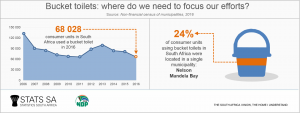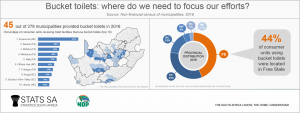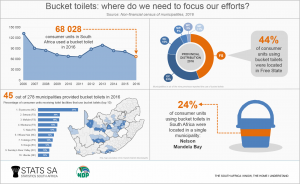Municipalities: where are the bucket toilets?
At the end of last year, mayor of Nelson Mandela Bay Athol Trollip made a commitment that the city would eradicate bucket toilets in informal settlements by the end of 20171. It’s not surprising that the pledge was made: the municipality has the highest number of bucket toilets in the country, according to data released from Stats SA’s latest Non-financial census of municipalities report.
Despite Nelson Mandela Bay making headway in reducing the number of consumer units2 using bucket toilets from a high of 30 202 in 2013 to 16 317 in 2016, the system remains an ugly reality for many residents. In May 2016, frustrations over bucket toilets erupted into a violent service delivery protest within the city3.
The discontent is understandable: of the 68 028 consumer units in South Africa using a bucket toilet in 2016, 24% were located in Nelson Mandela Bay.
Politicians and municipal administrators speak out against bucket toilets while residents find the system deplorable. Nonetheless, 45 of South Africa’s 278 municipalities still provide communities with this form of sanitation, with most of these in Free State, Northern Cape and Eastern Cape.
Municipalities responding to the Non-financial census of municipalities survey often state that their initial intention is to provide bucket toilets as a temporary measure while more permanent sanitation options are being considered. Various factors – including a lack of funding – often delay the process, making it difficult to replace bucket toilets once they’ve been introduced.
The evidence indicates a decrease in the number of bucket toilets in recent years, with municipalities making a concerted effort to provide other options such as septic tanks and flush toilets. During 2016, two more municipalities managed to eradicate bucket toilets entirely: Khâi-Ma and Siyathemba, both located in Northern Cape.
In trying to figure out which municipalities struggle the most, it’s useful to consider another way of looking at the data. Nelson Mandela Bay might have the highest prevalence of bucket toilets in the country, but it also has one of the largest populations. If the number of consumer units using bucket toilets is expressed as a percentage of total domestic consumer units receiving some form of toilet facility, Nelson Mandela Bay loses its top spot.
Instead, Siyancuma in Northern Cape comes out as the municipality with the highest percentage of domestic consumer units using bucket toilets, followed by Setsoto (Free Sate) and Mafube (Free State).
So will Nelson Mandela Bay keep its promise of totally eradicating bucket toilets by the end of this year? Stats SA will be your go-to source to answer this question, as the data will appear in its 2017 release of Non-financial census of municipalities report. So watch this space!
Visit the download page for the 2016 Non-financial census of municipalities report here. The PDF report and Excel file with municipal data are available. Data on bucket toilets are available in Table 9.
2 A consumer unit is an entity to which the service is delivered, and which receives one bill if the service is billed, alternatively known as a delivery point. This concept is often referred to as a household by municipalities, but this is not strictly correct, as households and consumer units do not coincide one to one, particularly in blocks of flats, on stands where there are multiple households in the same dwelling, or in additional dwellings, such as garden flats, backyard rooms, etc., and in the case of public taps.
3 http://www.groundup.org.za/article/bucket-system-must-go-say-pe-protesters/
Complete infographic:




